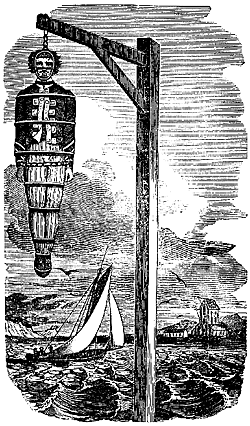The following post was written by Treasure Island Assistant Director and Dramaturg Rebecca Fredrickson.
 Legal punishments for piracy were harsh and often fatal. Generally, in the 17th century, all British pirates were sent to London for trial, where they would be locked away in the dismal Newgate Prison. This hostile environment also included the ‘pressing yard’, where jailors would tie suspected pirates to the ground and place heavy weights on their chests until they either confessed to piracy or died. If they managed to survive the unfriendly conditions of Newgate, they would face trial and, if they were found guilty, hanged. These hangings would occur at low tide, and the incoming tide would actually cover the bodies. They were often left hanging for days to serve as an example to others considering a similar career. Occasionally, pirates would be pardoned, especially if they were young and potentially reformable. Also, pirates who could prove that they were pressed into service were sometimes spared.
Legal punishments for piracy were harsh and often fatal. Generally, in the 17th century, all British pirates were sent to London for trial, where they would be locked away in the dismal Newgate Prison. This hostile environment also included the ‘pressing yard’, where jailors would tie suspected pirates to the ground and place heavy weights on their chests until they either confessed to piracy or died. If they managed to survive the unfriendly conditions of Newgate, they would face trial and, if they were found guilty, hanged. These hangings would occur at low tide, and the incoming tide would actually cover the bodies. They were often left hanging for days to serve as an example to others considering a similar career. Occasionally, pirates would be pardoned, especially if they were young and potentially reformable. Also, pirates who could prove that they were pressed into service were sometimes spared.
After 1700, courts in the colonies were allowed to try their own pirates, though pirates in Britain were still considered to be under the jurisdiction of the lord high admiral in London. Also, in 1717, King George I issued a proclamation pardoning any pirates who turned themselves in before a certain deadline. This resulted in the issuing of hundreds of certificates of pardon, though these often deterred their recipients from piracy for only a short time. It was also possible for pirates who were never caught red-handed to escape prosecution, even living out more honest later lives.
Although there was no official law or code among pirates, there were some standards that were generally followed. While naval and merchant vessels had strict chains of command, pirate ships were run democrat ically. The captain was elected by the crew, and if they felt the captain was doing a poor job, the captain could be voted out and replaced. Any attack or heading would also be put to a vote. However, the acting captain had absolute power over the ship during pursuit and battle.
Pirate ships were also governed by ‘articles’, documents of rules that would be drawn up at the beginning of voyages and upon the election of a new captain. They would be signed by every member of a pirate crew. These articles outlined punishments for rule-breaking and principles for the division of loot as well. It was also nearly universal that these articles protected the individual crew members’ right to get drunk, and alcoholism was rampant.
Our thrilling adaptation of Treasure Island runs Nov 22-Dec 24. Click here for more information and tickets.
Want to learn more? Check out these books!
Alfred P. Rubin. “The Law of Piracy”.
Benerson Little. “The Sea Rover’s Practice: Pirate Tactics and Techniques, 1630-1730”.
Children: John Hamilton. “Pirates in the Media”.